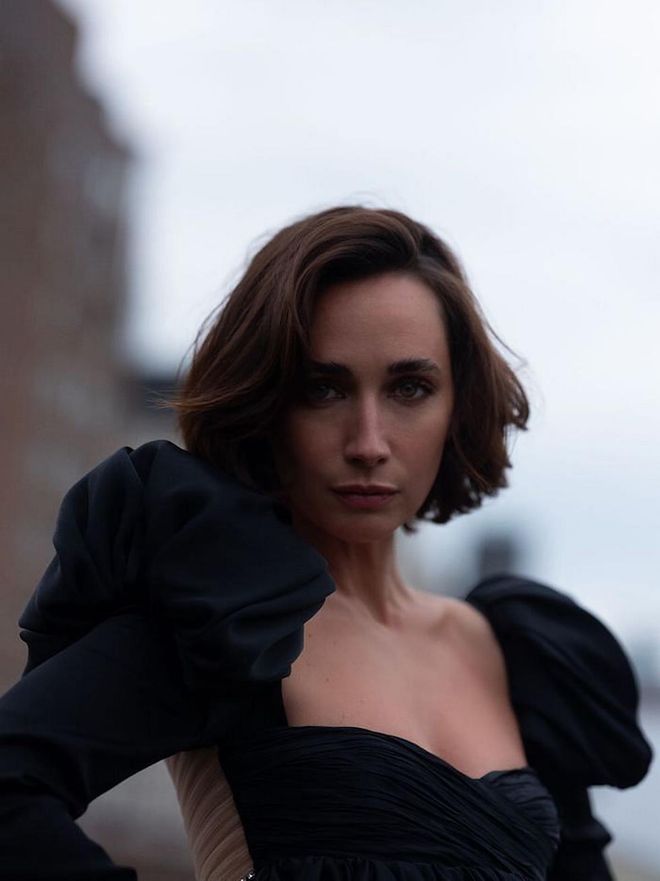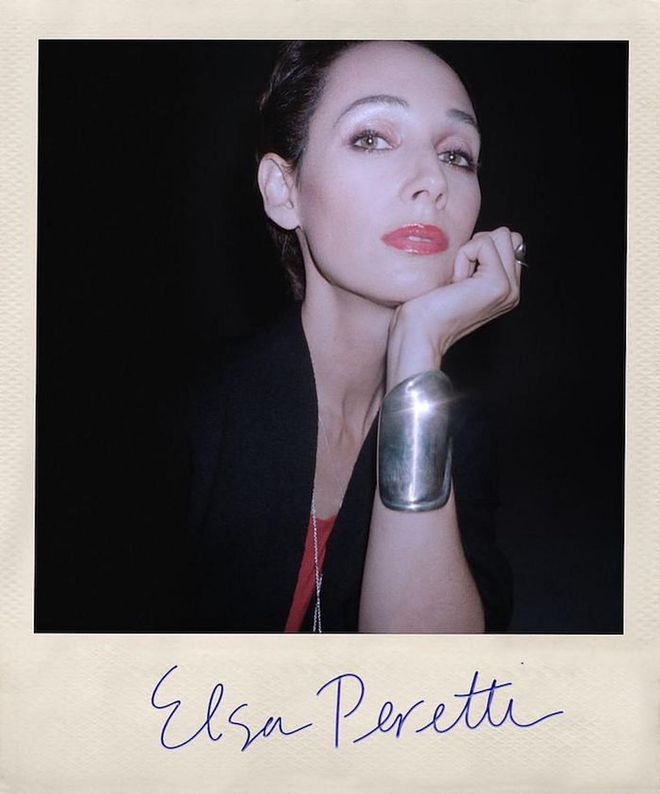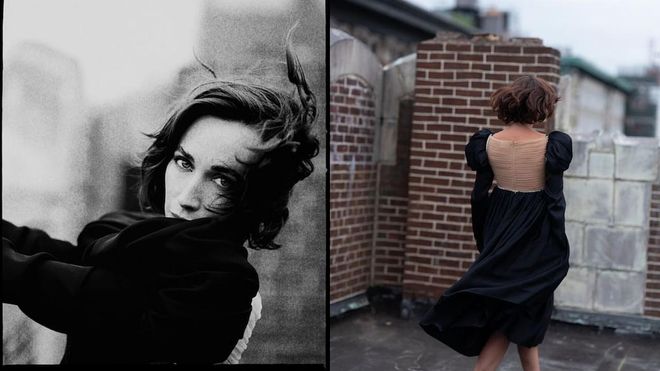Playing Elsa Peretti In ‘Halston’ Taught Actress Rebecca Dayan To Never Compromise
The budding star on portraying the famous jewelry designer and working with Ewan McGregor.


Rebecca Dayan (Photo: Kat Irlin)
Rebecca Dayan was hoping that, after life somewhat returned to normalcy, she would finally get to meet Elsa Peretti, the fashion icon and jewellery designer she portrays on Netflix’s Halston. But she never got the chance; Peretti passed away in March at 80 years old.
“It was really sad, because I was hoping that once the world reopened, that I would get to meet with her,” Dayan tells BAZAAR.com over Zoom, speaking from her New York City apartment. She reveres the late Italian designer, perhaps so much so that she downplays her take on her life. “Maybe she would’ve hated the way I portray her,” Dayan jokes. “I hope not.”
Related article: The Halston Family Says That Netflix’s Show About The Designer Is “Inaccurate”
Peretti leaves behind an illustrious legacy that includes designing some of Tiffany & Co.’s most famous pieces, like the Bone Cuff, Snake Necklace, and Open Heart pendants. But before her career with the jeweller took off, she was a good friend and muse to Roy Halston Frowick. Known widely by just his middle name, he was a titan of women’s fashion in the ’60s and ’70s. As their friendship deepened, so did their creative partnership; Peretti went from being Halston’s fit model to designing the unique teardrop bottle for his signature perfume.

Rebecca Dayan as Elsa Peretti in Netflix’s 'Halston'. (Photo: Netflix)
Directed by Daniel Minahan and starring Ewan McGregor in the titular role, Halston shows Peretti by the designer’s side through it all—from the early days of his brand in a shoddy atelier, to his peak in the Studio 54 era, to the downfall of his brand—until the messy ending of their tight but volatile bond. Though Dayan didn’t get to speak to anyone who knew Peretti in real life, what she gathered from her research with books and documentaries was that the designer was down to earth, despite her stature. “She was an icon, but that was kind of something that was projected onto her rather than really who she was and how she was living. I think she was very real.”

Elsa Peretti circa 1978 in New York. (Photo: Getty Images)
Here, she opens up about immersing herself in fashion history, working with McGregor, and dedicating time to charitable work outside of Halston.
Not much, to be honest. I knew her designs for Tiffany's, but I did not know anything about her life. I knew about Halston, but I had no idea of her involvement with Halston at all. So discovering all of that and more of her personal life and her as a creative force and as a woman in general was really interesting.
Everything I could put my hands on, I watched. I watched the Halston documentary. I watched all the interviews I could find of Elsa on YouTube. I watched all the Battle of Versailles documentaries. And Dan [Minahan] has a crazy archive of clippings from magazines and old issues of Interview magazine and a lot of books as well. That was definitely really helpful to have him. And he knows the subject so well, because, obviously, he's been developing this project for [over] 20 years.
We know her for her work, but we don't really know how much sacrifice went into her being able to come up with that body of work. As a young woman in the early '60s, when she decided to pursue her dream of being a designer and wanted to go to school in Barcelona, her father cut her off. She came from a really high-society, very rich family, and her father was not supportive of her choice. I'm sure things like that still happen today, but we think of that time period as being, you know, [about] women's emancipation and the women's liberation movement and all of that—and women still had to fight for the things they wanted. She had to not talk to her family for years and kind of just went off on her own and not compromise. That was definitely not something I knew and definitely was very inspiring.
We started filming before the pandemic. I got cast in, I think it was December 2019, and we went into production in February 2020. We got to film, I think, for four weeks and then shut down. Then we had a long break and went back in rehearsals in September, and then back to filming in October of 2020, pretty much all the way up until Christmas.
It was scary for multiple reasons, because I'd never had to interrupt a job and then go back to that job. But also working with the new COVID protocols was very, What's going to happen? What if someone gets sick? Which, we were super lucky that that never happened, because we had a really great COVID team.
But it was also very exciting. I think we were just so happy to be working, so happy to go back and finish telling the story that that kind of overcame all the other aspects of it.

Photo: Kat Irlin
We filmed Episode 1 before COVID. I think we were done with Episode 1 and a couple of scenes of Episode 2, and then everything else we shot [after the hiatus]. Studio 54 was afterwards, [the Battle of] Versailles was afterwards. It was crazy.
The first scene we filmed when we got back was the scene at the beach house where me and Halston get in a fight. That was really daunting, because it was a really big scene, but everyone is loose at the table, smoking cigarettes, doing drugs, all this stuff. And we were in masks, and everyone around looks like a doctor. The off-camera and on-camera are just two completely different worlds. So that was strange. I'm hoping I don't have to do it that way again, but I'm extremely thankful we were able to do it and that we stayed safe and healthy during the whole time.
We had the opportunity [to bond] before, when we were filming before COVID and before we started filming even. Dan wanted to make sure that we all felt like friends. He got us to spend a lot of time together doing different things on our off days. We all met for lunch once at Bergdorf's, and then went to all the actual locations [from Halston's life portrayed in the show], like the townhouse and the old studio that now is a Max Mara store, I think. We had this whole field trip day, basically, as a group. We had dinner at Dan's. I cooked for everybody. We kept doing things like that, that made sure there was a natural dynamic between all of us, and between me and Ewan.
How would you describe Elsa's relationship with Halston?
It's a complicated relationship for sure. I think they both really loved and admired each other. They were very supportive of each other. He was definitely some sort of, I don't like the word, but kind of a mentor, too, because he really believed in her, and she says herself she learned a lot from him. But I think he learned a lot from her as well, even though they were in this position where she was the muse at first, but then became a full-on collaborator. And then, they had this obsession with one another; I mostly read about that, how people were describing their relationship, that they were constantly in need of each other's attention. Theirs was a very fiery, volatile relationship. They were very jealous of each other. I think Joe Eula said that if Halston had been straight, she probably would have been his great love of his life. They did everything together. I think the only thing they didn't do together was have sex.
They were very intertwined, and that's why it makes it so much more heartbreaking but at the same time completely inevitable that that's the way that it has to end.

Ewan McGregor and Rebecca Dayan as Halston and Elsa Peretti. (Photo: Jojo Whilden/Netflix)
Modelling was always kind of a side thing that I did. I was modelling while I was studying. I never really had a real career. She had way more of a career than I did. But I do a lot of different things. I paint, I worked in fashion, I designed. So I can relate to her touching on a lot of different mediums. The thing that I can relate to the most is her process as an artist. … I think it was something very organic. She was very inspired by nature and by the simplicity of things.
[Nods yes.] I got to wear some vintage ones also, because Tiffany's doesn't make the equestrian belts anymore. So those were vintage. And I have a scene where I'm wearing a silver mesh bra under a blazer. That also was, I think, an original piece. I was wearing original Halston pieces in some scenes. It was a combination of vintage pieces, archives, and then custom-made pieces.
The doc is finished, and we're right now trying to find it a home so that people can watch it. So, hopefully, it will be available soon. I became very interested in birth a little over 10 years ago when I watched a documentary and got very moved. I had a very physical reaction to watching a natural home birth. And then, I became obsessed with birth, and I was in my early 20s and I would talk about it, and most of the people around me were all in their early 20s. They were like, "What are you talking about? Why do you care about this right now?" So I kept it in the back of my head.
My friend, Paula—who's the director, we produced together, and she’s the writer of the doc—is a mother, and told me that she wanted to make a documentary about birth in America. And I was like, "Well, that's crazy, because I've always been interested in the subject." I had just no idea that the maternal mortality rate was rising in America. That was something as a result of what I knew was poor treatment and of women in hospitals. It felt really crucial to do something.
We decided to start Mother Lover, because there are a lot of nonprofits that provide a lot of services that are needed at the grassroots level, like doulas and midwives and all sorts of other things. We don't provide that. But what we felt was missing was that all these people are doing all this work all over the States, all over the world in general, and it seems like little Band-Aids everywhere. We just want to put stories together and amplify them and give them a platform where it can become this bigger story that is more on the forefront of people's consciousness so that we can create real change at a bigger level. Born Free is the first endeavor towards that.
Last question: What do you hope people take away from watching Halston?
That you should never compromise. I think that's the lesson.
This interview has been edited and condensed for clarity.
Photographer: Kat Irlin
Stylist: Shibon Kennedy
Hair: Blake Erik
Makeup: Cyndle Komarovski
Dress and shoes by Khaite.
This article first appeared on Harper's BAZAAR US